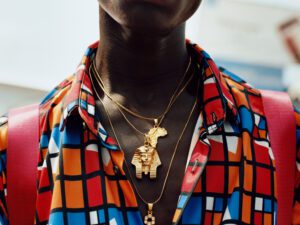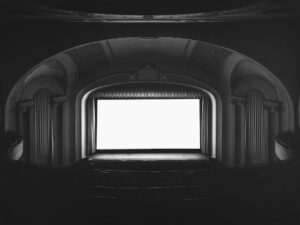“The audacity of hope, the bold declaration to believe and clarity of vision for a better life and world are the seeds of personal growth, revolutionised societies and life-changing technologies. Desire, hope and imagination are the cornerstones of social change and the first targets for those who fight against it.” In Afrofuturism: The World of Black Sci-Fi and Fantasy Culture (2013), author Ytasha Womack discusses the power of imagination within Afrofuturism. Creative voices, from filmmakers to photographers, present visions of what could be. These inspire hope, which propels us to transform tomorrow for the better. In recent years, we’ve seen Afrofuturism become an enormous cultural phenomenon, from Janelle Monáe’s album Dirty Computer (2018) to Marvel’s Black Panther (2018) to Hayward Gallery’s Into the Black Fantastic (2022). Now, Galerie Gomis welcomes audiences into an immersive exhibition that illustrates the threads connecting culture, innovation and tradition within the work of eight photographers connected to Africa.

Visual artists Ruby Okoro creatives fantastical scenes by adding elements of the supernatural to the everyday. The self-taught Nigerian image-maker began his career through colourful paintings with grand compositions. These qualities comes through in his current photographic projects. The series Heavens Belong to You (2021) could easily have been plucked out of a sci-fi story or a dream. In one shot, two figures appear to levitate in the red mist at their feet. Their head coverings extend in tendrils down over their faces whilst wavy lines mark their torsos, creating a beautiful marbled effect. The subjects are bathed in a red light that has become a staple of Okoro’s practice. In an interview with Metal, he explains: “I love the intensity, it lends to a visual story and the way it also transforms a scene from ordinary to magical.”
Elsewhere, Kyle Weeks (b. 1992) is breaking boundaries in a different way. The photographer subverts conventions of portrait photography by honouring the authenticity of his subjects. He is part of a generation of contemporary camera artists who are reconsidering the relationship between the person in front of and behind the lens. Projects such as Bieke Depoorter’s A. (2017-2020), Karabo Mooki’s Island Gals (2022), Snezhana von Büdingen-Dyba’s Meeting Sofie (2017-2020) and Yao Yuan’s 12321 (2017-2019) are all examples of the connection between everyone involved in the picture-taking process. Weeks honours the individuality of his subjects in his first photo book Good News (2023). He prioritised consensual collaboration to represent subjects as they wanted to be seen. This comes from an awareness of the harmful stereotypes about Africans perpetuated by the camera. He states: “Portraits are by nature the result of relationships… As contentious as the idea of artistic intention can be, I firmly believe that my intention to make empowering imagery from within Africa shapes my approach to portraiture.”


Representation is also at the core of Alexia Fiasco’s (b. 1990) project Les Dernieres Fauvettes. Blue cyanotypes show people from the Les Fauvettes housing estate in the Parisian suburb Pierrefitte. They preserve the memories and experiences of people living in a neighbourhood on the verge of demolition. The project tells the story of a city in terms of relationships rather than brick, concrete and steel. Fiasco’s wider practice explores post-colonial representation whilst fighting against restrictions to cultural experiences. Another series, ADN (2022), shows immigrant families in France in their private spaces. The choice of setting counters existing narratives that focus on struggle. In an interview with writer Sarah Souli, Fiasco states: “If we’re here today it’s not just because France permitted us to be here, it’s because our families were super present – or not – but fought for what they have, for us to be where we are.”
The images we see can change our perceptions and fuel our imaginations. These photographers broaden our minds by highlighting the power of interpersonal bonds, the beauty of seeing someone as they are and the freedom of imagination. This show is a testament to photography’s power to transcend culture, geography and time. Future Now serves as a reminder that tomorrow is still in the making.
Galerie Gomis: Future Gaze | Until 30 March
Words: Diana Bestwish Tetteh
Image Credits:
- Gleeson Paulino, Refúgio Refuge Rio Negro, Amazonas (2019).
- Togo Yeye, Simélan (Fish from the water), from the series Denim Dreams, My Chest Has Its Reason (2023).
- Gleeson Paulino, Refúgio Refuge Rio Negro, Amazonas (2019).
- © Ruby Okoro, Untitled, from the series Heavens Belong to You, (2021).





